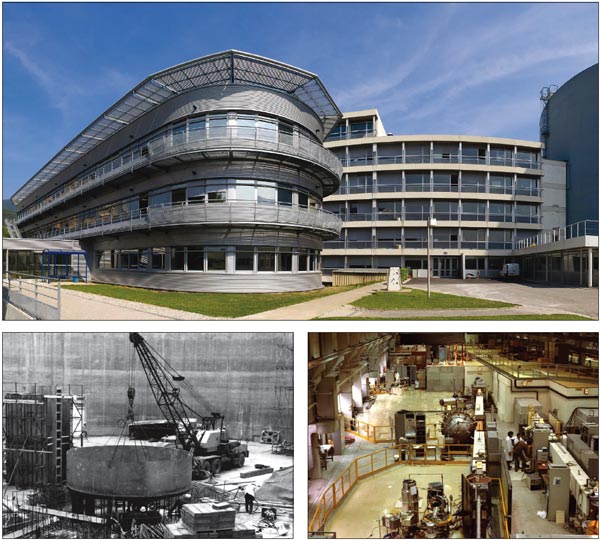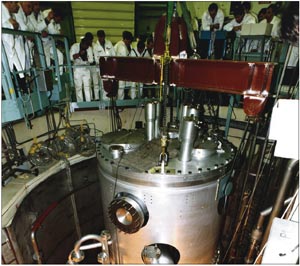A look at the world’s most powerful neutron source for science.
The Institut Laue-Langevin was founded on 19 January 1967 with the signing of an agreement between the governments of the French Republic and the Federal Republic of Germany. In recognition of this dual nationality it was named jointly after the two physicists Max von Laue of Germany and the Frenchman Paul Langevin. The aim was to create an intense source of neutrons devoted entirely to civil fundamental research. The facility was given the status of “service institute” and was the first of its kind in the world. It was to be the world’s leading facility in neutron science and technology, offering the scientific community a combination of unrivalled performance levels and unique scientific instrumentation in the form of a very large cold neutron source equipped with 10 neutron guides – each capable of providing three or four instruments with a very high-intensity neutron flux.

Image credit: ILL/Artechnique.
The construction of the institute and its high-flux reactor in Grenoble represented an overall investment of 335 million French francs (1967 prices, equivalent to about €370 million today) and was jointly undertaken by France and Germany. The reactor went critical in August 1971 and reached its full power of 57 MW in December that same year. Since then, the high-flux reactor has successfully maintained its position as the most powerful neutron source for scientific research in the world.
The UK joined the two founding countries in 1973, becoming the institute’s third full associate member. Over the following years, the level of international co-operation has gradually been extended, with a succession of “scientific membership” agreements with Spain (1987), Switzerland (1988), Austria (1990), Russia (1996), Italy (1997), the Czech Republic (1999), Sweden and Hungary (2005), and Belgium and Poland (2006).
The ILL is operated jointly by France, Germany and the UK, and has an annual budget of around €74 million. It currently employs around 450 staff, including 70 scientists, about 20 PhD students, more than 200 technicians, 60 reactor operations and safety specialists, and around 50 administrative staff; the breakdown by nationality is 65% French, 12% German and 12% British.
The ILL is a unique research tool for the international scientific community, giving scientists access to a constantly upgraded suite of high-performance instruments arranged around a powerful neutron source. More than 1500 European scientists come to the institute each year and conduct an average of 750 experiments. Once their experiment proposal has been accepted by the Scientific Council, scientists are invited to the institute for an average period of one week.
The fields of research are primarily focused on fundamental science and are extremely varied, including condensed matter physics, chemistry, biology, nuclear and particle physics and materials science. Thanks to the combination of an intense neutron flux and the availability of a wide range of energies (from 10–7 eV to 105 eV), researchers can examine a whole range of subjects. The samples that are studied can weigh anything from a tenth of a milligram to several tonnes. Most of the experiments use neutrons as a probe to study various physical or biological systems, while others examine the properties of the neutrons themselves. It is here that there is the most overlap with the physics of elementary particles and where low-energy physics can help to tackle and solve problems usually associated with high-energy physics experiments, as the following selected highlights indicate.
Neutron basics
The neutron is unstable and decays into a proton together with an electron and an anti-neutrino. Its lifetime, τn, is one of the key quantities in primordial nucleosynthesis. It determines how many neutrons were available about three minutes after the Big Bang, when the universe had sufficiently cooled down for light nuclei to form from protons and neutrons. It therefore has a strong influence on the abundance of the primordial chemical elements (essentially 1H, 4He, 2H, 3He and 7Li).

Image credit: ILL/Artechnique.
Twenty years ago, in an experiment at ILL, Walter Mampe and colleagues achieved a new level of precision in measuring τn by storing ultracold neutrons in a fluid-walled bottle and counting the number of neutrons remaining in the bottle for various storage times. The experiment used a hydrogen-free oil to coat the walls in order to minimize the loss of neutrons in reflections at the walls. The final result of τn = 887.6 ± 3 s was the first to reach a precision well below 1% (Mampe et al. 1989). This value has found a number of applications, in particular making it possible to derive the number, N, of light neutrino types from a comparison of the observed element abundances with the predicted ones. The argument depends on the relationship between N and the expansion-rate of the universe during nucleosynthesis: the more light neutrinos that contribute to the energy density, the faster the expansion, leading to different element abundances. The result from ILL led in turn to a value of N = 2.6 ± 0.3 which made a fourth light neutrino generation extremely unlikely (Schramm and Kawano 1989). The stringent direct test that N is indeed equal to 3 came soon after with a precision measurement of the width of the Z boson at the LEP collider at CERN.
The neutron lifetime also feeds into the Standard Model of particle physics through the ratio of the weak vector and axial-vector coupling constants of the nucleon. Together with the Fermi coupling constant determined in muon decay, it can be used to determine the matrix element Vud of the Cabibbo–Kobayashi–Maskawa matrix. This in turn, provides a possibility for testing the Standard Model at the low-energy frontier and is one of the continuing motivations to improve still further the measurements of the neutron lifetime and of decay asymmetries in experiments at the ILL and elsewhere.

Image credit: ILL.
Another key property of the neutron for particle physics is the hypothetical electric-dipole moment (EDM), which has a high potential importance for physics beyond the Standard Model. The existence of an EDM in the neutron would violate time-reversal, T, and hence – through the CPT theorem – CP symmetry. The Standard Model predicts an immeasurably small neutron EDM, but most theories that attempt to incorporate stronger CP violation beyond the CKM mechanism predict values that are many orders of magnitude larger. An accurate measurement of the EDM provides strong constraints on such theories. A positive signal would constitute a major breakthrough in particle physics.
In 2006, a collaboration between the University of Sussex, the Rutherford Appleton Laboratory and the ILL announced a new tighter limit on the neutron’s EDM. Based on measurements using ultracold neutrons produced at the ILL, the upper limit on the absolute value was improved to 2.9 x 10–26 e cm (Baker et al. 2006). The experiment stored neutrons in a trap permeated by uniform electric and magnetic fields and measured the ratios of neutron-to-mercury-atom precession frequencies; shifts in this ratio proportional to the applied electric field may in principle be interpreted as EDM signals.
E really does equal mc2
Particle physics makes daily use of the relationship between mass and energy, expressed in Albert Einstein’s famous equation. An experiment at the ILL in 2005 combined with one at the Massachusetts Institute of Technology (MIT), made the most precise direct-test of the equation to date, with researchers at ILL measuring energy, E, while the team at MIT measured the related mass, m. The test was based on the fact that when a nucleus captures a neutron, the resulting isotope with mass number A+1 is lighter than the sum of the masses of the original nucleus with mass number A and the free neutron. The energy equivalent to this mass difference is emitted as gamma-rays, the wavelength of which can accurately be measured by Bragg diffraction from perfect crystals.
The team at MIT used a novel experimental technique to measure the masses of pairs of isotopes by comparing the cyclotron frequencies of the two different ions confined together in a Penning trap. They performed two separate experiments, one with 28Si and 29Si, the other with 32S and 33S, leading to mass differences with a relative uncertainty of about 7 × 10–8 in both cases. At the ILL, a team from the National Institute of Standards and Technology measured the energies of the gamma-rays emitted after neutron capture by both 28Si and 32S using the world’s highest-resolution double crystal gamma-ray spectrometer, GAMS4. The combination of the high neutron flux available at the ILL reactor and the energy accuracy of the GAMS4 instrument allowed the team to determine the gamma-ray energies with a precision of better than 5 parts in 10,000,000. By combining the mass differences measured in America and the energy measurements in Europe, it was possible to test Einstein’s equation, with a result of 1–γmc2/E = (–1.4 ± 4.7) × 10–7 – which is 55 times more accurate than the previous best measurements (Rainville et al. 2005).

Image credit: ILL.
The German physicist Max von Laue (1879–1960) received the Nobel Prize in Physics in 1914, in Stockholm, for demonstrating the diffraction of X-rays by crystals. This discovery revealed the wave nature of X-rays by enabling the first measurements of wavelength and showing the organization of atoms in a crystal. It is at the origin of all analysis methodology based on diffraction using X-rays, synchrotron light, electrons or neutrons.
Paul Langevin (1879–1946) was an eminent physicist from the pioneering French team of atomic researchers, which included Pierre and Marie Curie. A specialist in magnetism, ultrasonics and relativity, he also dedicated 40 years of his life to his responsibilities as director of Paris’s Ecole de Physique et de Chimie. His study of the moderation of rapid neutrons, i.e. how they are slowed by collisions with atoms, was invaluable for the design of the first research reactors.
These three examples give only a tiny glimpse into one aspect of the science that is undertaken at the ILL each year, illustrating the possibilities for testing theories in particle physics and cosmology. The institute looks forward to the next 40 years of fruitful investigations and important results in these fields as well as across many other areas of science.





